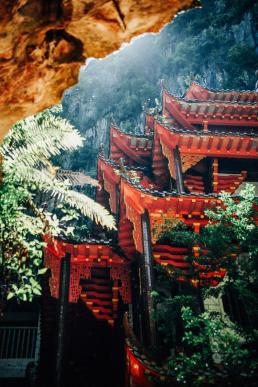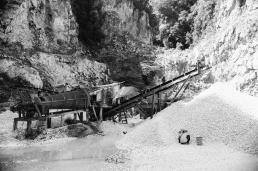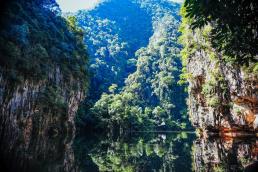Ipoh is recognised for its chicken rice, kopitiam culture and the surrounding limestone caves. It’s also no secret that Ipoh is set to be the Peninsular’s next big development, being on the peripheral of Penang and a growing city. It’s a beautiful thing, to be waking up to a city that is surrounded by a ring of fog encasing both the hills and the city.
Coincidentally, I was in town during Wesak, so we decided to pay a visit to the Sam Poh Tong Temple just on the outskirts of the city. Though I’ve been here before, there is still something serene about an arresting vermillion temple built in a private enclave. The only disappointment is that it is closed at most times – today was not an exception either as the gates were locked.

The crowds were many, rushing in and out of the cave whilst the monks carried on in their procession, chanting and chiming the gong occasionally. Among the sea of black robes, I spotted an aged man with gold robes leading the chant, occasionally starting the verses. The smell of incense hung in the air; ripe with devotion and focus. Eventually, I left to search for the elusive Tasik Cermin. It’s something I’ve heard murmured often but still a secret of sorts.
Tasik Cermin
According to blogs out there, Tasik Cermin is located in one among the many quarries in the vicinity of Gunung Rapat. The road is an unassuming one, tucked beside a car showroom right beside the main road. When the tar road turns into gravel and limestone dust clouds your vision as your drive past industrial sites, you know you’re heading in the right direction. It wasn’t soon before we arrived, driving past ancient broken gates and greeted by a huge machine chomping away at the white earth. At the entrance, we asked directions from a worker, who told us to either drive straight in or we could park the vehicle at the entrance and walk in. He rode away on his motorcycle, content enough with giving us vague directions.
We drove in a little further into the barren wasteland and parked our car. From here on, we were walking.

The quarry was a private desert and we were surrounded by looming natural monuments, older than these machines and older than ourselves. And here we were, mining these structures of their richness and making an industry out of it. I couldn’t imagine how the health conditions of these workers are like, inhaling limestone dust every day into their lungs.
While the land isn’t large, the walk is certainly challenging under the scorching sun and bone-dry earth the winds blowing dust about you. We asked around and was eventually led to a tunnel in one of the mountains, with a dim light at its end. A torchlight isn’t necessary unless you’re worried about accidentally stepping on puddles and getting your footwear wet. A minute in, and the light grew larger as we soon slowly began to see the paradise hidden within.

According to the caretaker (the same man we met at the entrance), the lake was discovered ten years ago when the quarry works started. Since then, he has been taking care of the lake, a small paradise in a limestone enclave. I could only imagine that this beauty can only last for long before industrial needs take over and the limestone mountains are mined further for profit. And when that time comes, the lake would be exposed and no longer a paradise.
For most parts, Tasik Cermin is a secret only shared by word of mouth – though more and more people are beginning to know of its existence and paying this enclave a visit.
“Just last week, five busloads of people just came around,” he says. Apparently, you can fish here, something he was doing whilst we conversed. While the tranquility of the lake gives no indication to its depth, several few brave folks have dived in the lake. He finishes his kretek and paddles his raft away, finding a more quiet spot to fish – away from the noise, and us.